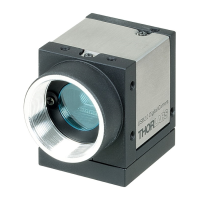© 2016 Thorlabs Scientific Imaging486
DCx Camera Functional Description and SDK Manual
Pixel clock frequency: Reduce the pixel clock if data transfer errors occur. When you are
operating more than one USB camera on one port, the pixel clock of all the cameras added
together should not exceed about 40 MHz.
Is it possible to operate an older USB camera with Windows 7?
Look for the serial number to see if your camera can be operated with Windows 7:
The support for Windows 7 was introduced with driver version 3.50. This driver can be used with
cameras from serial number 400 26 27000 on.
6.1.1 PCs with Energy Saving CPU Technology
This application note is related to all DCx USB cameras connected to PC systems using current
CPU models that implement modern energy saving technologies.
Symptoms:
- Low USB bandwidth provided by the PC system
- TransferFailed errors occurring even at moderate pixel clock settings
- Camera operates at low speed only
Summary:
Current CPUs with modern energy saving features can cause bandwidth limitations on USB. The
only available approach to this issue is to disable CPU sleep states. Unfortunately this is not
possible for all systems.
Detailed explanation:
Modern CPUs like Intel i5 & i7 and others make use of advanced energy saving technologies
ensuring a low power consumption and long battery life for mobile
devices. Additionally those CPU implement features for increasing the performance of single cores
if there is enough thermal headroom available when other cores have little load.
A basic idea to achieve this is to put a CPU core to sleep while there is nothing to do for it. Various
different activity states of CPU cores are available in modern CPUs. These CPU states are
referred to as “C-states”. C0 is the working state of a core.
Increasing numbers refer to less activity and longer wake up times. Current CPU fall down to
variations of the C3 state which are referred to as “Sleep”, “Deep Sleep” and similar.
Unfortunately negative effects of the sleep states have shown up. It is observed that the available
bandwidth of PC busses drops significantly when part of the CPU enters these states.
The operation of DCx USB cameras is affected by the sleep states because they reduce the
speed of the USB system. The available bandwidth on the USB may drop down to around 30% of
the maximum bandwidth when the CPU, or one of its cores, enters sleeping states.
One would expect that a CPU core will not fall into a sleep state while it is obviously needed for the
operation of the USB. But obviously USB data transfers do not prevent the CPU from falling to
sleep. If the code execution load of a CPU core is low enough it will fall asleep and immediately
reduce the USB bus speed.
For operation at high frame rates DCx cameras require an adequate USB bandwidth which might
not be available when CPU cores are in sleep states.
Advice:
If you seem to be running into this low bandwidth issue please check and try the following. These
first hints are general recommendations for issues with the USB
data transfer. You can check the USB performance with the “Optimum” pixel clock settings
checkbox in uc480 Demo software. A good USB system should be able to reach a pixel clock

